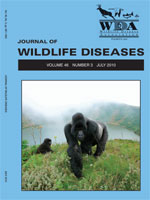One of the most severe threats to bighorn sheep (Ovis canadensis) populations is disease. With the objective of projecting possible epizootic consequences to bighorn sheep population dynamics, we examined 23 epizootic mortality episodes from presumably known causes that occurred in the United States and Canada from 1942 to 2005. These outbreaks were correlated with population size using regression models. Epizootic origins were documented by considering contact with a “new” pathogen for the bighorn sheep population or pneumonic processes, presumably triggered by stress. We suggest mortality rates are negatively related to population size in a logarithmic function, and offer a model to estimate the percentage of disease-related mortalities for a given population size of bighorn sheep. From a disease dynamics perspective, we suggest a minimum population of 188 bighorn sheep would be required to insure long-term persistence in the presence of epizootic disease.
How to translate text using browser tools
1 July 2010
MORTALITY DURING EPIZOOTICS IN BIGHORN SHEEP: EFFECTS OF INITIAL POPULATION SIZE AND CAUSE
Ivonne Cassaigne G.,
Rodrigo A. Medellín,
José A. Guasco O.
ACCESS THE FULL ARTICLE

Journal of Wildlife Diseases
Vol. 46 • No. 3
July 2010
Vol. 46 • No. 3
July 2010
diseases
epizootics
Ovis canadensis
population size




